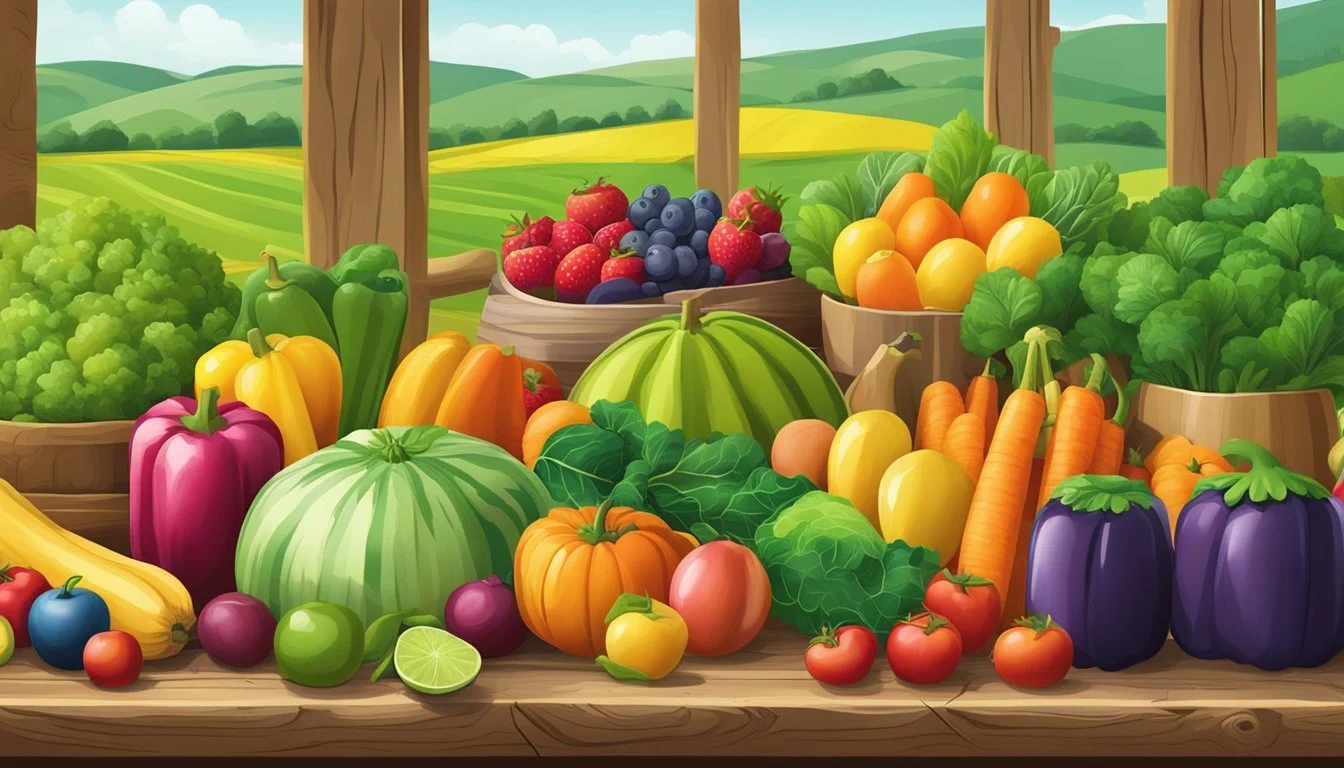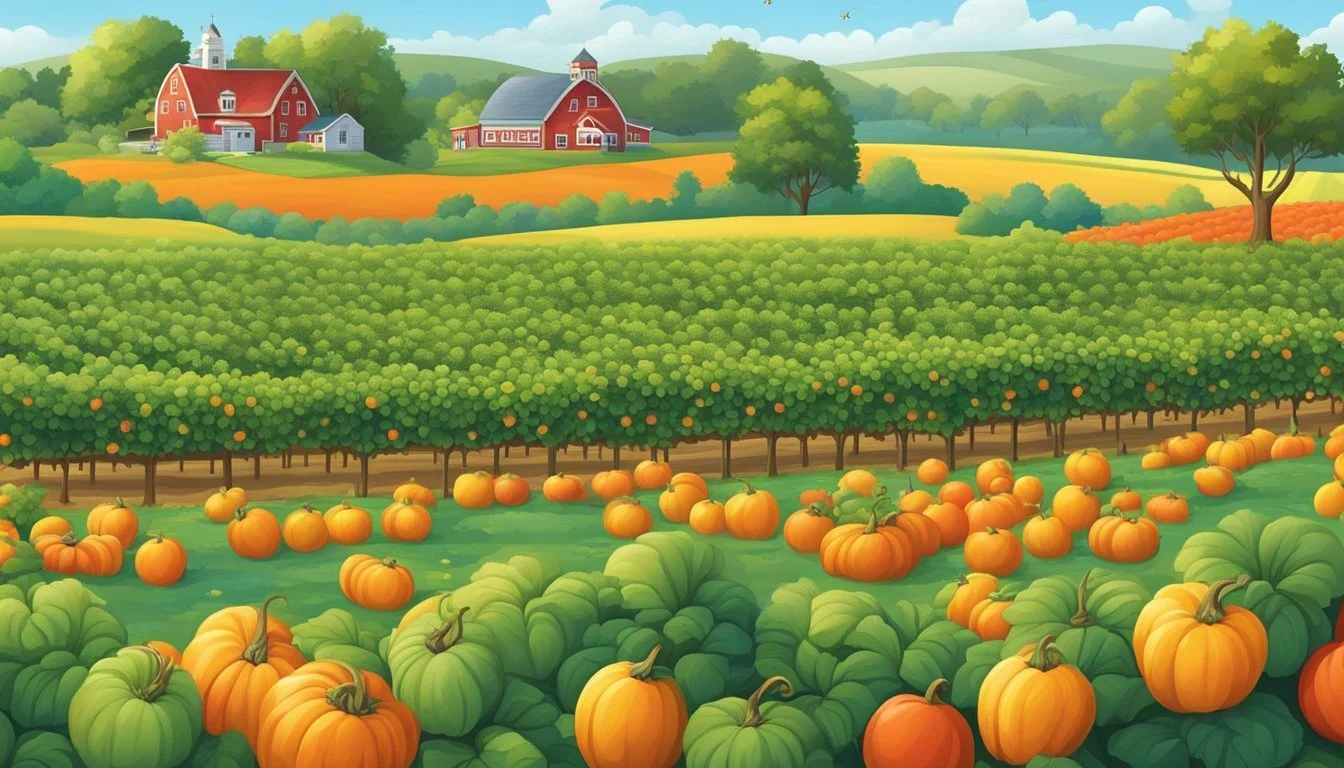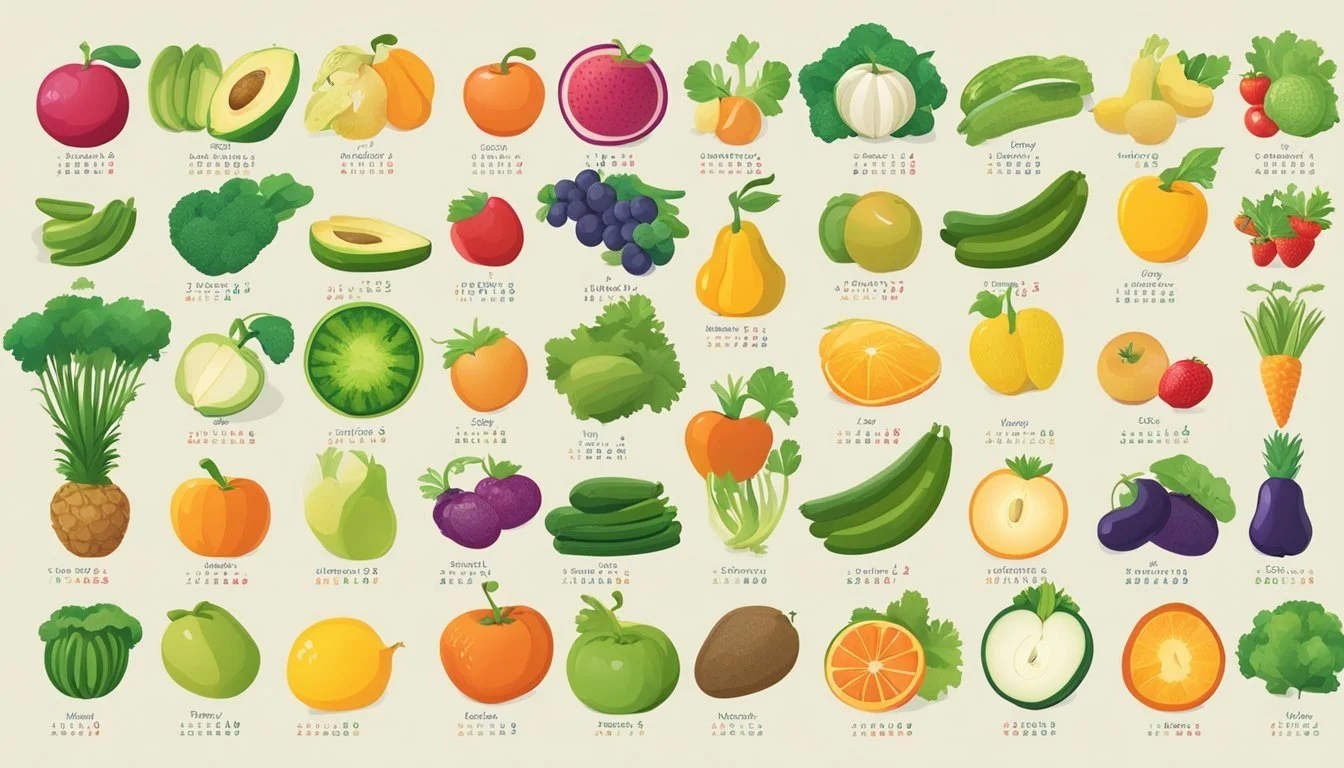Washington Seasonal Fruit & Veg Guide
Your Quarterly Harvest Roadmap
Washington stands as a beacon of the farm to table movement, with an abundance of fresh produce that varies from season to season. From the lush, green Pacific Northwest to the drier eastern regions, the state’s diverse climates support a wide range of fruits and vegetables, perfect for a local and seasonal diet. As a center of diverse agricultural production, Washington's farmers markets and local farms are crucial in connecting the community to fresh, nutritious food.
Throughout the year, the seasonal rhythms of Washington's agricultural bounty are evident in the array of produce available. Winter months might offer hearty root vegetables and crisp apples (how long do apples last?), while the summer brings with it a colorful selection of berries, stone fruits, and vibrant greens. The adherence to seasonal availability not only supports local farming but also ensures that consumers enjoy the freshest and most flavorful produce. By engaging with local farms and markets, consumers take part in a sustainable food ecosystem, fostering a closer relationship with the land and the seasons.
This guide serves as a pathway to understanding the seasonal cycles and the wide variety of produce that Washington has to offer. It helps navigate the peak seasons for farming outputs, which is valuable for anyone interested in making the most of what their local environment provides. Embracing seasonality means relishing each fruit and vegetable at its very best, while supporting local agriculture and reducing the environmental impact of food transport.
What’s in Season in Washington Right Now?
The Importance of Seasonality
Highlighting the significance of timing, the following discussion will focus on how understanding seasonal eating and reaping the benefits of seasonal produce can lead to an enriched culinary experience and support local ecosystems.
Understanding Seasonal Eating
Seasonal eating refers to the practice of consuming fruits and vegetables around the time they are naturally harvested within a local area. When produce is in season, it typically peaks not just in terms of abundance, but also in terms of flavor and nutritional content. For instance, Washington's apple harvest in the fall ensures that consumers enjoy the freshest and most flavorful apples during this time. Eating with the seasons also supports the natural growing cycles and reduces reliance on out-of-season imports that might not match the fresh, quality standards of locally sourced goods.
Benefits of Seasonal Produce
Eating produce when it's in season offers several benefits:
Peak Flavor: Fruits like strawberries and tomatoes are notably more flavorful when allowed to ripen naturally and consumed soon after harvest.
Nutritional Value: Seasonal produce can be more nutritious, as the time between harvest and consumption is shorter, preserving more vitamins and minerals.
Environmental Impact: Choosing seasonal, local foods reduces the carbon footprint associated with transportation and storage of out-of-season imports.
Economic Support: Purchasing in-season items from local farms and markets supports the local economy and farming communities.
By valuing seasonality, consumers ensure that they enjoy fresh, flavorful food, while also contributing to environmental sustainability and economic viability of local producers.
Washington's Growing Regions
Washington's diverse geography and climate contribute significantly to its status as a powerhouse in agricultural production within the Pacific Northwest. This state's yield is due in large part to the distinct growing regions, each serving as a foundation to various crops throughout the seasons.
Climate Variations Across the State
Washington's climate ranges from coastal to semi-arid conditions. The western part of the state benefits from a marine climate known for cool summers and mild winters, fostered by the nearby Pacific Ocean. Contrastingly, the central and eastern regions lie in the rain shadow of the Cascade Range, leading to drier conditions that are more conducive to different types of crops.
Key Agricultural Areas
Western Washington:
Dominant in berry and vegetable cultivation.
Central Washington:
Known for tree fruit orchards, especially apples, cherries (how long do cherries last?), and pears.
Eastern Washington:
The Palouse region is ideal for dry land farming, particularly grains and legumes.
Each area's unique characteristics contribute to Washington's bountiful harvests and its stand-out role in the region's farm to table movement.
Seasonal Produce Calendar
Washington's diverse climate presents a vast range of fresh produce year-round. The following calendar breaks down the state's offerings by season, ensuring one can find the freshest fruits and vegetables at local markets.
Spring Harvest
April: As the ground thaws, spring brings tender greens and the first of the year's harvest. Markets begin to fill with:
Greens: Spinach, Arugula, Mesclun Mixes
Vegetables: Radishes, Rhubarb, Asparagus (how long does asparagus last?)
Summer Bounty
May to August: The warm and dry summer accelerates growth, leading to an abundance of produce.
May: Cherries and strawberries make their sweet debut, along with:
Vegetables: Peas, Green Onions, Lettuce
June and July: Berries are in full swing alongside stone fruits and staple summer vegetables.
Fruit: Raspberries, Blueberries, Apricots, Peaches
Vegetables: Summer Squash, Cucumbers (how long do cucumbers last?), Tomatoes
August: The peak of summer yields the most variety, including:
Fruit: Apples, Pears, Plums
Vegetables: Bell Peppers, Eggplant, Corn
Autumn Selections
September to November: As the weather cools, fall harvest begins with heartier staples.
September: Early apples and pears continue, while pumpkins and winter squash emerge.
Fruit: Early Fall Apples, Pears
Vegetables: Winter Squash, Pumpkins
October: Root vegetables and late-season fruits are dominant.
Fruit: Late Fall Apples, Cranberries
Vegetables: Beets, Carrots, Potatoes
November: The harvest begins to wane, but hardy greens and winter vegetables are still abundant.
Greens: Kale, Collards
Vegetables: Brussels Sprouts, Cabbage
Winter Offerings
December to February: While many fields lay fallow, Washington provides through stored crops and greenhouse-grown produce.
December and January: Root vegetables and storage crops dominate the offerings.
Vegetables: Onions, Garlic, Stored Root Vegetables
February: The tail end of winter sees the last of stored produce and the beginnings of early spring greens.
Vegetables: Overwintered Spinach, Green Onions
Fruits of Washington
Washington State is renowned for its wide variety of fruits, with the growing seasons bringing a bountiful harvest. The state’s unique climate allows for the cultivation of a range of fruits from juicy berries to crisp tree fruits.
Berries and Soft Fruits
In Washington, berries peak in the summertime. Blueberries are at their best from July to September, while raspberries thrive from June through August. Blackberries are also commonplace and follow a similar seasonal pattern. Strawberries, however, mark the beginning of the berry season, with their peak availability from June to July.
Tree Fruits
Washington's tree fruits are a cornerstone of the state's agricultural output. Apples, perhaps the most iconic, are harvested from August to November. Pears follow suit, with a season that typically runs from August to February. Cherries have a shorter season, from June to August, but their sweet taste is much anticipated. Stone fruits like peaches, apricots, and nectarines ripen in the warmth of summer, generally between June and September.
Other Seasonal Fruits
Apart from the well-known berries and tree fruits, Washington offers a selection of other seasonal fruits. Grapes are harvested in the fall, from August to October, perfect for wine making and fresh eating. Less common but equally delightful, persimmons make their appearance towards the end of the year, typically in October and November.
Vegetables Throughout the Year
Washington's diverse climate and fertile soils yield a plethora of vegetables year-round. Understanding when these vegetables reach their peak can enhance the flavor and nutritional value of meals.
Leafy Greens and Herbs
Leafy greens are a cornerstone of the Washington harvest, with a variety that spans throughout the year.
Chard: Available from May through February, chard is versatile and nutrient-dense.
Lettuce: Peaks in the summer months but generally accessible year-round.
Arugula: Often found in mesclun mixes; its peak season is from spring to fall.
Herbs such as cilantro, parsley, and basil are usually most abundant in the summer months.
Root Vegetables and Tubers
These vegetables are hearty and store well, making them a staple in the off-season.
Potatoes: Harvested in the summer and fall, they are often available throughout the year due to their storability.
Carrots: June through January sees the sweetest carrots.
Beets: Typically found from June through October.
Garlic and Onions: Garlic is typically harvested in July but is available year-round, whereas onions peak from summer through fall.
Parsnips and Rutabaga: Enjoy these sweet, root vegetables mainly in the fall and winter.
Nightshades and Cucurbits
These vegetables flourish in warm weather and bring color to the summer tables.
Tomato & Tomatoes: Best from July through September; warm, sunny days yield the sweetest fruit.
Peppers: Like tomatoes, they peak in the summer to early fall.
Cucumbers: Crisp and fresh, cucumbers are best from July through September.
Squash & Zucchini: Abundant in the summer, with winter varieties available into the fall.
Pumpkins: Associated with fall and primarily available in September and October.
Eggplant: Enjoy these typically from July through September.
Incorporating these vegetables into seasonal meals not only supports local agriculture but also provides the freshest flavors and greatest nutrition available from Washington's bountiful lands.
Enhancing Food with Herbs and Other Edibles
Integrating fresh herbs and unique edibles into one's diet can elevate the flavor profile of dishes while providing nutritional benefits. Washington's diverse climate offers a range of aromatics and uncommon edibles that can be used to enhance the culinary experience.
Aromatic Herbs
Washington's rich soil yields a variety of aromatic herbs that play a crucial role in culinary arts. Sage, with its earthy and slightly peppery taste, is a staple for poultry and meat dishes. Rosemary, known for its needle-like leaves and distinctive woodsy aroma, is ideal for seasoning grilled meats, focaccia, and roasted potatoes. Thyme is another versatile herb, with a subtle, dry aroma and a slight minty flavor, suitable for soups, stews, and marinades.
Sage:
Flavor: Earthy, peppery
Uses: Poultry, meat dishes, sausages
Rosemary:
Flavor: Woodsy, lemon-pine
Uses: Grilled meats, bread, potatoes
Thyme:
Flavor: Subtle, minty
Uses: Soups, stews, sauces
Mint is refreshingly cool and sweet, commonly infused into beverages, used in fresh salads, or added to desserts for a burst of flavor. Less commonly used but equally flavorful, sorrel offers a lemony tang, perfect for a unique twist in salads and sauces. For those interested in home brewing or adding a unique bitter flavor to dishes, hops can be cultivated and used for their distinctive taste.
Edible Flowers and Other Uncommon Finds
Beyond traditional herbs, edible flowers and niche edibles add a decorative yet functional element to Washington’s local cuisine. Flowers such as lavender can be used to add a sweet, floral aroma to baked goods and to craft soothing teas. Chefs and home cooks also forage for wild edibles like nettles, which can be prepared similarly to spinach and offer a rich, earthy green taste.
When incorporating edible flowers and unconventional greens into dishes, it is important to correctly identify and source these ingredients to ensure they are safe and palatable for consumption. Knowledge of seasonal availability and proper preparation methods is essential for using these unique ingredients to their full potential.
Cooking and Preserving
Washington's bountiful seasons offer an array of fruits and vegetables perfect for enriching the culinary experience. One can translate these seasonal offerings into delightful dishes and preserve their essence for enjoyment year-round.
Seasonal Recipes
Spring:
Asparagus: Grilled with a touch of olive oil, sea salt (how long does sea salt last?), and a squeeze of lemon.
Cherries: Fresh cherry pie to capture the sweetness of the season.
Summer:
Blueberries: Blueberry cobbler utilizing July's peak harvest.
Tomatoes: Gazpacho made with ripe, juicy varieties picked in August.
Fall:
Apples: Classic apple crisp that celebrates the diverse apple varieties of Washington.
Pumpkins: Savory pumpkin soup with ingredients harvested in October.
Winter:
Root Vegetables: Roasted beets and carrots with herbs, harvested before the frost sets in.
Preservation Techniques
Fruits: Peaches and pears can be canned in light syrup.
Vegetables: Pickles and relishes using late summer cucumbers and peppers.
Cold Storage:
Apples: Store in a cool, humid place to maintain texture and flavor.
Root Vegetables: Kept in a dark, cool environment can last throughout the winter.
Freezing:
Berries: Frozen at peak ripeness to retain maximum flavor.
Corn: Blanched and frozen soon after harvest to preserve sweetness.
Drying:
Herbs: Air-dried or dehydrated to use in dishes all year long.
Tomatoes: Sun-dried for a concentrated flavor, excellent for sauces and toppings.
Community and Events
In Washington State, the farm to table movement enriches community events and dining experiences. Residents and visitors alike immerse themselves in the local agrarian lifestyle through bustling farmers markets and vibrant farm to table restaurants.
Farmers Markets and Festivals
Washington's farmers markets reflect the state's agricultural diversity. Seattle's iconic Pike Place Market operates year-round, offering a tapestry of seasonal produce, artisanal foods, and handmade crafts. Seasonal festivals, such as the Yakima Valley Spring Harvest Festival, celebrate the bountiful local harvests, showcasing an array of fruits, vegetables, and regional specialties.
Eastern Washington embodies a tradition of larger festivals, with events like the Wenatchee Apple Blossom Festival highlighting the local apple harvest.
Western Washington counters with a cascade of seafood and berry festivals, each emphasizing sustainable, locally-sourced offerings.
Farm to Table Restaurants and Artisans
Farm to table restaurants throughout Washington champion the connection between local farms and culinary craftsmanship. In Seattle, establishments such as Tilth and The Herbfarm present seasonally rotating menus, thoughtfully curated to reflect the freshest local ingredients. Artisans complement these dining experiences, with local cheese makers, butchers, and bakers infusing a taste of Washington in every dish.
In the Yakima Valley, restaurants like Crafted integrate the day's harvest into creative courses, underscoring the farm-to-fork ethos.
Beyond Seattle, small-town eateries and local food artisans across the state invite diners to partake in a journey of flavor, tracing the origin of each ingredient from soil to plate.









